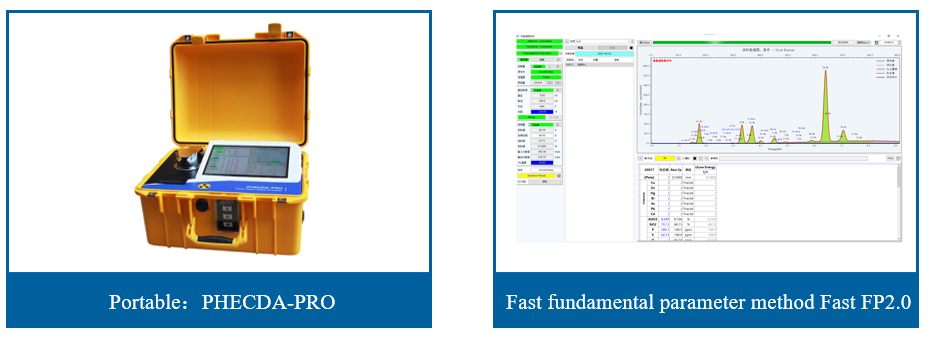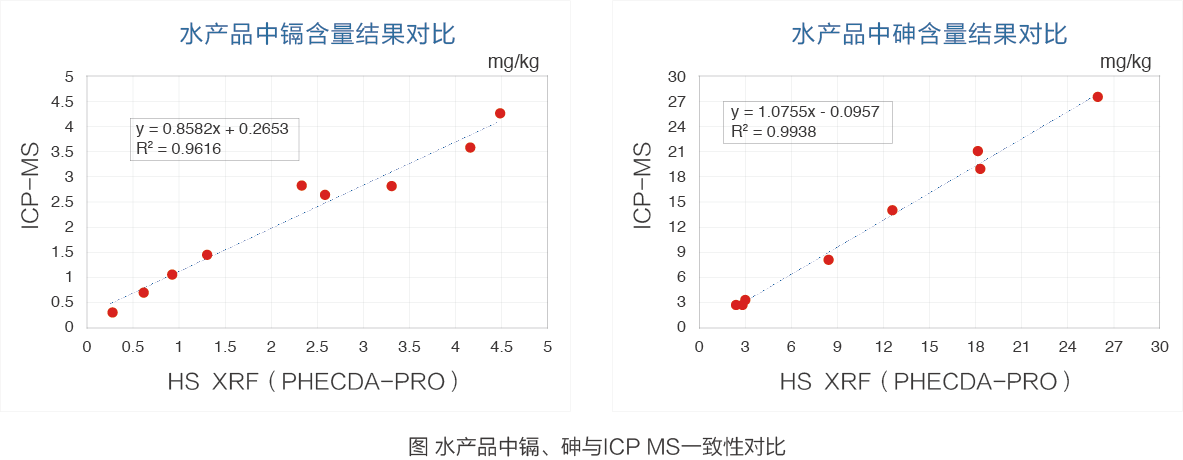


| Heavy metal elements |
Lead |
Cadmium |
Mercury |
Arsenic |
Chromium |
Nickel |
Tin |
Thallium |
| Detection limit① |
0.07 | 0.03 | 0.1 | 0.06 | 0.2 | 0.1 | 0.1 | 0.08 |
| Type of food | Number of tests | XRF test value(mg/kg) | |||||
| As | Pb | Cd | Cr | Ni | Sn | ||
| Soya beans | Fixed value | 0.15 | 0.10 | 0.12 | 0.54 | 3.16 | 1.15 |
| Mean(n=7) | 0.13 | 0.10 | 0.12 | 0.53 | 3.23 | 1.24 | |
| Standard deviation(SD) | 0.021 | 0.023 | 0.014 | 0.065 | 0.064 | 0.049 | |
| Relative Standard Deviation(RSD) | 16% | 24% | 12% | 12% | 2% | 4% | |
| Pork | Fixed value | 0.25 | 0.30 | 0.30 | 1.18 | 3.22 | 1.21 |
| Mean(n=7) | 0.30 | 0.26 | 0.28 | 1.31 | 3.32 | 1.28 | |
| Standard deviation(SD) | 0.039 | 0.029 | 0.021 | 0.076 | 0.091 | 0.069 | |
| Relative Standard Deviation(RSD) | 13% | 11% | 8% | 6% | 3% | 5% | |
| Cabbage | Fixed value | 0.50 | 0.40 | 0.40 | 2.53 | 3.46 | 1.27 |
| Mean(n=7) | 0.56 | 0.46 | 0.45 | 2.44 | 3.43 | 1.23 | |
| Standard deviation(SD) | 0.026 | 0.034 | 0.022 | 0.083 | 0.097 | 0.057 | |
| Relative Standard Deviation(RSD) | 5% | 7% | 5% | 3% | 3% | 5% | |
| Thirteen-spices | Fixed value | 1.23 | 0.49 | 0.20 | 2.59 | 0.08 | 1.23 |
| Mean(n=7) | 1.23 | 0.53 | 0.23 | 2.47 | 0.12 | 1.23 | |
| Standard deviation(SD) | 0.033 | 0.043 | 0.028 | 0.089 | 0.037 | 0.058 | |
| Relative Standard Deviation(RSD) | 3% | 8% | 12% | 4% | 30% | 5% | |
| Sample name | As(mg/kg) | Pb(mg/kg) | Cd(mg/kg) | ||||||
| Standard values | FP calculated value | Relative error | Standard values | FP calculated value | Relative error | Standard values | FP calculated value | Relative error | |
| GBW10049(Onion) | 0.52±0.11 | 0.50 | -3% | 1.34±0.16 | 1.30 | -3% | 0.19±0.02 | 0.16 | -14% |
| GBW10018(Chicken) | 0.109±0.013 | 0.14 | —— | 0.11±0.02 | 0.12 | 6% | 0.005 | 0.088 | —— |
| GBW07604(Poplar Leaf) | 0.37±0.09 | 0.41 | 13% | 1.5±0.3 | 1.28 | -15% | 0.32±0.07 | 0.31 | -4% |
| GBW10024(Scallop) | 3.6±0.6 | 3.5 | -4% | 0.12 | 0.18 | —— | 1.06±0.1 | 1.0 | -5% |
| GBW10022(Garlic Powder) | 0.31±0.04 | 0.30 | -5% | 0.72±0.09 | 0.84 | 17% | 0.062 | 0.08 | 29% |
| GBW10050(Prawn) | 2.5 | 2.6 | 4% | 0.20±0.05 | 0.17 | -15% | 0.039±0.002 | 0.05 | —— |
| GBW10051(Pig Liver) | 1.4±0.3 | 1.4 | 3% | 0.12±0.03 | 0.13 | 9% | 1.00±0.07 | 0.87 | -13% |
| GBW10048(Celery) | 0.39±0.08 | 0.43 | 10% | 2.7±0.7 | 2.15 | -20% | 0.092±0.006 | 0.15 | —— |
| GBW10021(Beanstalk) | 0.15±0.02 | 0.22 | —— | 0.66±0.07 | 0.69 | 5% | 0.02 | 0.024 | 24% |
| GBW(E)100377(Brown Rice) | 0.498±0.030 | 0.58 | 18% | 0.220±0.020 | 0.16 | -26% | 0.261±0.020 | 0.32 | 24% |
| GBW(E)100380(Maize) | 0.277±0.023 | 0.337 | 22% | 0.417±0.030 | 0.39 | 18% | 0.045±0.004 | 0.09 | — |
| GBW10046(Henan Wheat) | 0.025 | 0.021 | -16% | 0.067±0.016 | 0.023 | — | 0.018±0.002 | 0.035 | — |
| METAL-DJTZK-014(Brown Rice) | 0.616±0.047 | 0.760 | 23% | 0.340±0.030 | 0.28 | -17% | 0.704±0.055 | 0.79 | 13% |



 High sensitivity X-ray fluorescence spectrometer(HS XRF®)
High sensitivity X-ray fluorescence spectrometer(HS XRF®) Advanced Fast Fundamental Parameters Method(Fast FP®)
Advanced Fast Fundamental Parameters Method(Fast FP®)

